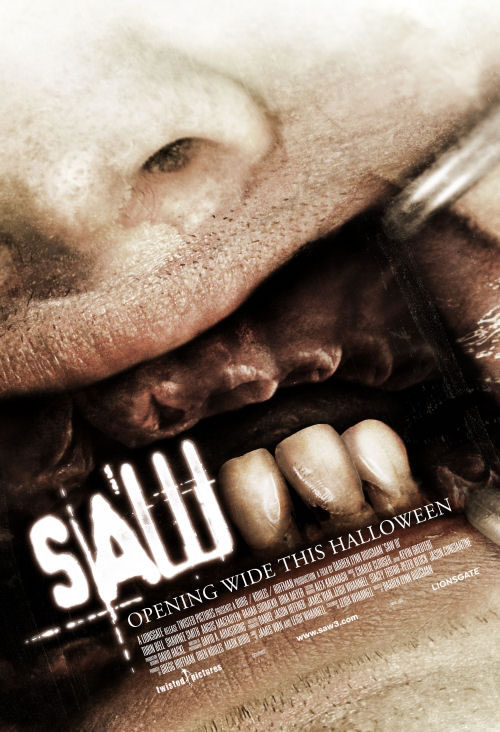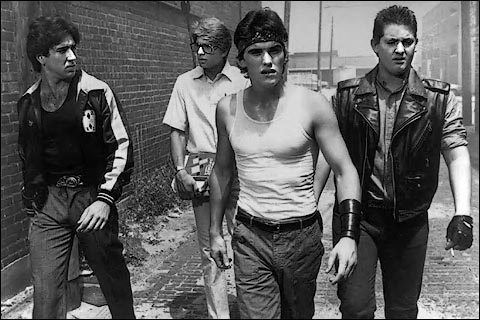 "Every Hero Has His Day." - Tagline for The One Last TimeIntroduction
"Every Hero Has His Day." - Tagline for The One Last TimeIntroductionThis is the beginning of a filmmaker - Weintrob might be the mext Spielberg, Ammo might be the next McG. The tagline above suits these filmmakers appropriately as this is where they start off - they have made it into the film world, but can they continue? I have had a few ideas for shorts myself lately and I thought that The Times Film Festival would give me an opportunity to watch some shorts that have 'made it'. A book I am reading has given me the impression that film-shorts merely showcase your talent for a feature film and, in the case of
Fetch you can see that these filmmakers are aware of this facet. The cinema we watched it in introduced the directors to a few and they were obviously very pleased with themselves with the odd friend-of-the-film acting a little too arrogant for my liking. Then again, if I was there, I may just act the same. There are a few to get through, so I shall keep this short. There is an epilogue to this post to summarise the films watched
What I reckon ... All the films were to some extent to do with law-breakers and criminals in a different context: hence the title given, but they all 'went about it' in a different way. from the Blue Gordini's surrealism through to
Fetch's hyper-realism. So, in [pretty much] the order we watched the films in:
X Returns (Ammo, 2009)Set in Sydney, this is some Matrix-inspired action piece that, is ultimately awful. The only film that didn’t warrant clapping post-credits. Then again, it was the first film shown so maybe noone knew whether to clap or not. Strangely enough, Holly Valance (Kiss Kiss single, Flick-from-Neighbours … vivid teenage memories of her…) was in the film as some double-crossing … person. It was all unclear. It was non-linear – showing ‘X’ with a gun to Valance’s head before falling off the building at the start and then showing a conversation between Valance and some good guy? Bad guy? It’s never explored. ‘X’ has been imprisoned for 40 years because he contracted some Alien DNA … is he bad? Is he good? How did he survive the fall? Nothing is answered. Even the conversations seemed to be shot badly - from Over-the-shoulder shots to direct face shots ... no purpose, just uncomfortable. Awkward silence when the credits came up and the text was blurry.
The Man in the Blue Gordini (Jean-Christophe Le, 2009)Stunning animation from Jean-Christophe Lie. Surrealist story as a world soaked in different shades of orange, cream and brown are attempting to deal with a criminal who sports a blue top. Has a real European flavour and, I think the animation reeks of Quentin Blake’s drawings – thin Giacometti-like legs, heavy-topped characters. None of the characters wear clothes on their bottom half so we are lucky enough to see penis’ waggling throughout. Until the blue people rebel and wear trousers. Its funny and a lot of fun with an interesting subtext about what people see on the outside opposed to what is inside – people being arrested and caught, etc for ‘looking different’. Racial issues? Police discrimination? These issues are raised in a fun trouser-less world.
Harvest (Alex Winckler, 2009)Two thieves are trying to rob an old pig-farmers house. The one thief is a late thirties, early-forties man and has a family – but is ultimately trying to support his family through theft, while the other lad is a younger chap who is FUBAR. He craps in the old peoples house, he tries to nick everything that could get him money (something he could get a couple of quid for he, off-the-cuff, states ‘a beer’ … complete tramp) and ultimately tries to rape the old woman who lives there. Without going further then that in the plot, this film seems to look incredible – great tones and clearly sets the tone in such a rural landscape, but falls flat on the more technical aspects of film-making. Lots of obvious fade-to-blacks and sudden sounds to jolt us back into the film. The whole rape section is a bit unnecessary – especially because there was no need to show a specific ‘revealing’ shot. Its not explicit but the idea that ‘some things are better left in the imagination than shown’ is something director Alex Winckler didn’t feel appropriate. If the film was about rape then fine, but it wasn’t about rape – it was about petty thieves and the tables being turned on them.
The Odds (Paloma Baeza, 2009)An incredible short that utilises every aspect of a ‘short film’. Set in one room. Two actors (Mark Strong and Ian McDiarmid) and a very simple start: Strong is a casino manager while McDiarmid is a gambler who has won a freakish amount of games. It was rooted in drama and the tension flips from one character – we start unsure about who is ‘playing’ who and then it switches and switches again always putting you on edge – while an incredible finale finishes the short. I hope to see this film again and even Sarah is keen to hunt down a script to use with her pupils in Drama lesson. The picture I found above reminds me of McQueen's
Hunger and the inrecible discussion between the priest and Bobby Sands. Truly flawless.
Le Petit Dragon (Bruno Collet, 2009)It looks like stop-go-motion or incredibly sharp computer animation. The smoke of a dragon ‘awakes’ a Bruce Lee toy figure. To some extent it reeks of a Toy Story off-shoot, while Lee tackles different figures and bit-by-bit destroys himself. His ‘features’ remind me of Buzz's’ push-button selections. Though it explores a little bit more nostalgia than Toy Story as Lee comes face-to-face with not only the plastic toys (which he is not – he appears to be made out of those stress-relief materials) but, eventually a computer game which has, to some extent, taken over the role toys play in our family homes. Incredibly shot and clearly a work of art – I hope it is stop-go-motion because if it is incredible SFX then … actors are redundant.
 Fetch (Jyri Koski, 2009)
Fetch (Jyri Koski, 2009)A short that appears to be taken from feature length movie. Small-role actors from Martin Scorsese and Guy Ritchie's movies indicate that this hardly short of budget or contacts. Like a combination between Snatch and The Sopranos, we see an Afro-American gangster named Caesar (the actor Ade who plays Tryone in Snatch) come across OG’s – Original Gangster – Italians Vinni (Looks a lot like Uncle Jun’ from Sopranos) and henchman Tony to complete a job for them. A post-credits voice-message reveals what Vinni and Tony should have known … they don’t know much it turns out and we see quite the finale to a mistake at the end. Incredible acting and incredible roles that showcase the talent Jyri Koski has … I only hope that Koski creates a feature-film with the punch of this short. It would be difficult to pull-off though.
Trunk (Chrostopher D'Elia, 2008)Very simple story as two Uni Students set off on a road journey that escalates into chaos. It stars Zachary Ty Bryan from – recently watched
Held for Ransom - taking a potential frat-pack on a journey. It has you initially eager to see where it will go ... but then descends into a comedy. It is very funny but, at some points, the second actor Kyle Gallner, seems a bit too passionate for such a funny situation. I wouldn't be averse to watching it again, but there was something that lacked ... maybe credibility. No second layer - just fun and games.
 The One Last Time (Scott Weintrob, 2009)
The One Last Time (Scott Weintrob, 2009)An incredible short that, even though the last one shown, I would be prepared to say is the 'best'. IMDB seems to state that director Weintrob is now on a feature called
Bleed opposed to Ammo whose
X Returns put him in a position to do ... well ... nothing currently in production. This film seems inspired by Nolan's beginning
to The Dark Knight whereby the Joker and co - masked as clowns - raid a bank. The characters in this short raid a bank, masked in a similar way, but as the
Wizard of Oz characters ... only to find halfway through that another group are raiding the bank themselves. It looks so sharp and incredible showing this classical building raided by gun-toting bank robbers ... it could be the start of an incredible comedy-action movie but, as it progresses it utilises the nature of a short to finish exquisitely.
EpilogueWhen I watched
Dead Mans Shoes and
Saw I realised that you can see how some directors, writers, actors, etc have planned creatively to make a film that gives them an opportunity to showcase their talent within a realistic set/schedule, etc. The best shorts used a small cast and/or one set which would require very little shooting. Yes, some films clearly had money behind them but not all of them.
Fetch had money - yet we only saw one room, 5 actors during the same 10 mins. The animation ones are more difficult to navigate as they ahve alot more work involved but can be worked on consistently by the filmmakers.
The Odds - one set, one very simple set (a basement!) for that matter and two actors. Nothing more
. X-Returns and
Harvest were trying to be feature-length films condensed into 10 and 22 mins respectively. A great experience and i fully recommend hunting down my top 3 from the selection:
The Odds, The One Last Time and
Fetch.
 This week, Jo and I look at Saw VI while Richard Bourne (see the graffiti on the right...) joins us on the show to discuss Fantastic Mr. Fox and the range of ticket prices here in the UK.
This week, Jo and I look at Saw VI while Richard Bourne (see the graffiti on the right...) joins us on the show to discuss Fantastic Mr. Fox and the range of ticket prices here in the UK.








 "Every Hero Has His Day." - Tagline for The One Last Time
"Every Hero Has His Day." - Tagline for The One Last Time



